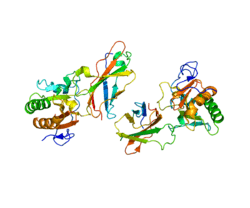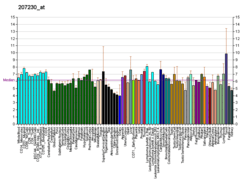CDON
Cell adhesion molecule-related/down-regulated by oncogenes is a protein that in humans is encoded by the CDON gene.[5][6]
CDON and BOC are cell surface receptors of the immunoglobulin (Ig)/fibronectin type III (FNIII) repeat family involved in myogenic differentiation. CDON and BOC are coexpressed during development, form complexes with each other in a cis fashion, and are related to each other in their ectodomains, but each has a unique long cytoplasmic tail.[6]
Structure and function
Cell adhesion molecule-related/down-regulated by oncogenes (CDON) is a conserved transmembrane glycoprotein belonging to a subgroup of the immunoglobulin superfamily of cell adhesion molecules.[7] It is highly expressed in both the somites and dorsal lips of the neural tube of embryonic day 8.5 mice. It is expressed in proliferating and differentiating myoblast cell lines, there is evidence showing its role in mediating the effects of cell–cell interactions between muscle precursors that are critical in myogenesis.[8] It is also expressed in neural crest precursor cells, it regulates the localization of N-cadherin providing a mechanism for directed neural crest migration.[9] CDON protein was shown to bind to all three mammalian isoforms of hedgehog proteins: Sonic Hh, Indian Hh, and Desert Hh.[10]
Clinical significance
CDON mutations are thought to diminish sonic hedgehog (SHH)-pathway activity which is important in stimulating cell proliferation, differentiation, and tissue patterning at multiple points in animal development. CDON was shown to play a role in differentiation of midbrain dopaminergic neurons through the interference with of Shh signaling pathway.[11] Mutations in CDON gene has been associated with Holoprosencephaly which is structural anomaly of the brain, in which the developing forebrain fails to correctly separate into right and left hemispheres.[12] CDON mutations synergistically interact with prenatal alcohol exposure to increase susceptibility to Holoprosencephaly.[13]
Gene knockdown studies
CDON knockdown using morpholinos in zebra fish altered the eye development, CDON was shown important in restraining the size of the optic stalk and ventral retina in chick embryos.[13] Additionally, double CDON knock out mice display optic nerve hypoplasia (ONH), a prominent feature of septo-optic dysplasia (SOD), the same phenotype shown by treating mice prenatally with ethanol.[14] CDON−/− animals also show cardiac dysfunction with increased fibrosis, those cardiac effects are mediated through hyperactivation of WNT/β-catenin signaling.[15]
Interactions
CDON has been shown to interact with CDH1[16] and BOC.[17]
References
- GRCh38: Ensembl release 89: ENSG00000064309 - Ensembl, May 2017
- GRCm38: Ensembl release 89: ENSMUSG00000038119 - Ensembl, May 2017
- "Human PubMed Reference:". National Center for Biotechnology Information, U.S. National Library of Medicine.
- "Mouse PubMed Reference:". National Center for Biotechnology Information, U.S. National Library of Medicine.
- Kang JS, Gao M, Feinleib JL, Cotter PD, Guadagno SN, Krauss RS (July 1997). "CDO: an oncogene-, serum-, and anchorage-regulated member of the Ig/fibronectin type III repeat family". The Journal of Cell Biology. 138 (1): 203–13. doi:10.1083/jcb.138.1.203. PMC 2139939. PMID 9214393.
- "Entrez Gene: CDON Cdon homolog (mouse)".
- Sanchez-Arrones L, Cardozo M, Nieto-Lopez F, Bovolenta P (May 2012). "Cdon and Boc: Two transmembrane proteins implicated in cell-cell communication". The International Journal of Biochemistry & Cell Biology. 44 (5): 698–702. doi:10.1016/j.biocel.2012.01.019. PMID 22326621.
- Kang JS, Mulieri PJ, Miller C, Sassoon DA, Krauss RS (October 1998). "CDO, a robo-related cell surface protein that mediates myogenic differentiation". The Journal of Cell Biology. 143 (2): 403–13. doi:10.1083/jcb.143.2.403. PMC 2132836. PMID 9786951.
- Powell DR, Williams JS, Hernandez-Lagunas L, Salcedo E, O'Brien JH, Artinger KB (November 2015). "Cdon promotes neural crest migration by regulating N-cadherin localization". Developmental Biology. 407 (2): 289–99. doi:10.1016/j.ydbio.2015.07.025. PMC 4663112. PMID 26256768.
- Kavran JM, Ward MD, Oladosu OO, Mulepati S, Leahy DJ (August 2010). "All mammalian Hedgehog proteins interact with cell adhesion molecule, down-regulated by oncogenes (CDO) and brother of CDO (BOC) in a conserved manner". The Journal of Biological Chemistry. 285 (32): 24584–90. doi:10.1074/jbc.M110.131680. PMC 2915694. PMID 20519495.
- Kwon YR, Jeong MH, Leem YE, Lee SJ, Kim HJ, Bae GU, Kang JS (September 2014). "The Shh coreceptor Cdo is required for differentiation of midbrain dopaminergic neurons". Stem Cell Research. 13 (2): 262–74. doi:10.1016/j.scr.2014.07.004. PMID 25117422.
- Bae GU, Domené S, Roessler E, Schachter K, Kang JS, Muenke M, Krauss RS (August 2011). "Mutations in CDON, encoding a hedgehog receptor, result in holoprosencephaly and defective interactions with other hedgehog receptors". American Journal of Human Genetics. 89 (2): 231–40. doi:10.1016/j.ajhg.2011.07.001. PMC 3155179. PMID 21802063.
- Hong M, Krauss RS (October 2012). "Cdon mutation and fetal ethanol exposure synergize to produce midline signaling defects and holoprosencephaly spectrum disorders in mice". PLoS Genetics. 8 (10): e1002999. doi:10.1371/journal.pgen.1002999. PMC 3469434. PMID 23071453.
- Kahn BM, Corman TS, Lovelace K, Hong M, Krauss RS, Epstein DJ (January 2017). "Prenatal ethanol exposure in mice phenocopies Cdon mutation by impeding Shh function in the etiology of optic nerve hypoplasia". Disease Models & Mechanisms. 10 (1): 29–37. doi:10.1242/dmm.026195. PMC 5278523. PMID 27935818.
- Jeong MH, Kim HJ, Pyun JH, Choi KS, Lee DI, Solhjoo S, O'Rourke B, Tomaselli GF, Jeong DS, Cho H, Kang JS (February 2017). "Cdon deficiency causes cardiac remodeling through hyperactivation of WNT/β-catenin signaling". Proceedings of the National Academy of Sciences of the United States of America. 114 (8): E1345–E1354. doi:10.1073/pnas.1615105114. PMC 5338397. PMID 28154134.
- Kang JS, Feinleib JL, Knox S, Ketteringham MA, Krauss RS (April 2003). "Promyogenic members of the Ig and cadherin families associate to positively regulate differentiation". Proceedings of the National Academy of Sciences of the United States of America. 100 (7): 3989–94. doi:10.1073/pnas.0736565100. PMC 153035. PMID 12634428.
- Kang JS, Mulieri PJ, Hu Y, Taliana L, Krauss RS (January 2002). "BOC, an Ig superfamily member, associates with CDO to positively regulate myogenic differentiation". The EMBO Journal. 21 (1–2): 114–24. doi:10.1093/emboj/21.1.114. PMC 125805. PMID 11782431.
Further reading
- Wegorzewska M, Krauss RS, Kang JS (May 2003). "Overexpression of the immunoglobulin superfamily members CDO and BOC enhances differentiation of the human rhabdomyosarcoma cell line RD". Molecular Carcinogenesis. 37 (1): 1–4. doi:10.1002/mc.10121. PMID 12720294.
- Cole F, Krauss RS (March 2003). "Microform holoprosencephaly in mice that lack the Ig superfamily member Cdon". Current Biology. 13 (5): 411–5. doi:10.1016/S0960-9822(03)00088-5. PMID 12620190.





